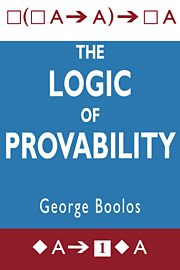Book contents
- Frontmatter
- Contents
- Preface
- Introduction
- 1 GL and other systems of propositional modal logic
- 2 Peano arithmetic
- 3 The box as Bew(x)
- 4 Semantics for GL and other modal logics
- 5 Completeness and decidability of GL and K, K4, T, B, S4, and S5
- 6 Canonical models
- 7 On GL
- 8 The fixed point theorem
- 9 The arithmetical completeness theorems for GL and GLS
- 10 Trees for GL
- 11 An incomplete system of modal logic
- 12 An S4-preserving proof-theoretical treatment of modality
- 13 Modal logic within set theory
- 14 Modal logic within analysis
- 15 The joint provability logic of consistency and ω-consistency
- 16 On GLB: The fixed point theorem, letterless sentences, and analysis
- 17 Quantified provability logic
- 18 Quantified provability logic with one one-place predicate letter
- Notes
- Bibliography
- Index
- Notation and symbols
8 - The fixed point theorem
Published online by Cambridge University Press: 08 January 2010
- Frontmatter
- Contents
- Preface
- Introduction
- 1 GL and other systems of propositional modal logic
- 2 Peano arithmetic
- 3 The box as Bew(x)
- 4 Semantics for GL and other modal logics
- 5 Completeness and decidability of GL and K, K4, T, B, S4, and S5
- 6 Canonical models
- 7 On GL
- 8 The fixed point theorem
- 9 The arithmetical completeness theorems for GL and GLS
- 10 Trees for GL
- 11 An incomplete system of modal logic
- 12 An S4-preserving proof-theoretical treatment of modality
- 13 Modal logic within set theory
- 14 Modal logic within analysis
- 15 The joint provability logic of consistency and ω-consistency
- 16 On GLB: The fixed point theorem, letterless sentences, and analysis
- 17 Quantified provability logic
- 18 Quantified provability logic with one one-place predicate letter
- Notes
- Bibliography
- Index
- Notation and symbols
Summary
The beautiful fixed point theorem for GL, due independently to Dick de Jongh and Giovanni Sambin, is the most striking application of modal logic to the study of the concept of provability in formal systems.
We recall the two definitions necessary for the statement of the theorem.
⊡A is the sentence (□A ∧ A).
A sentence A is said to be modalized in p if every occurrence of the sentence letter p in A is in the scope of an occurrence of □; equivalently, A is modalized in p if and only if A is a truth-functional compound of sentences of the form □D and sentence letters other than p.
The fixed point theorem then reads: For every sentence A modalized in p, there is a sentence H containing only sentence letters contained in A, not containing the sentence letter p, and such that GL⊢⊡(p↔A)↔⊡(p↔H).
Any such sentence H is called a fixed point of A.
If GL⊢H↔I, then GL⊢⊡(H↔I), and therefore GL⊢⊡(p↔H)↔⊡(p↔I). And if GL⊢⊡(p↔H)↔⊡(p↔I) and neither H nor I contains p, then substituting H for p yields GL⊢⊡(H↔H)↔⊡(H↔I), whence GL⊢H↔I. It follows that any sentence equivalent in GL to a fixed point of A and containing only sentence letters in A other than p is itself a fixed point of A, and that all fixed points of A are equivalent in GL.
- Type
- Chapter
- Information
- The Logic of Provability , pp. 104 - 123Publisher: Cambridge University PressPrint publication year: 1994



